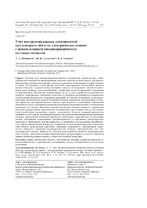| dc.contributor.author | Шейников, А. А. | ru |
| dc.contributor.author | Суходолов, Ю. В. | ru |
| dc.contributor.author | Зеленко, В. В. | ru |
| dc.coverage.spatial | Минск | ru |
| dc.date.accessioned | 2018-05-29T05:53:30Z | |
| dc.date.available | 2018-05-29T05:53:30Z | |
| dc.date.issued | 2018 | |
| dc.identifier.citation | Шейников, А. А. Учет инструментальных погрешностей при контроле обмоток электрических машин с использованием квазипериодических тестовых сигналов = Accounting of Instrumental Errors in the Control of Windings of Electrical Machines with the Use of Quasi-Periodic Test Signals / А. А. Шейников, Ю. В. Суходолов, В. В. Зеленко // Энергетика. Известия высших учебных заведений и энергетических объединений СНГ. - 2018. - № 3. - С. 235-245. | ru |
| dc.identifier.uri | https://rep.bntu.by/handle/data/41608 | |
| dc.description.abstract | Решение задач диагностирования обмоток электрических машин связано с необходимостью селекции квазипериодических тестовых сигналов на фоне шумов. Для выделения полезных сигналов, как правило, используют различия спектральных составов сигналов и шумов. В идеальном случае форма частотной характеристики оптимального фильтра должна совпадать с формой спектра полезного сигнала, что определяет сложность выполнения такого фильтра. Цель исследований – увеличение точности измерений и упрощение алгоритмического обеспечения измерительных систем за счет разработки математического аппарата, позволяющего однозначно определять и учитывать при обработке погрешности, обусловленные конечностью интервалов измерений. В условиях постоянного роста вычислительных возможностей средств измерений резервом повышения чувствительности методов обработки квазипериодических сигналов представляется установление однозначной зависимости между локальными вариациями временных параметров сигнала и изменениями параметров его спектра. Вариации значений параметров сигналов приводят к нарушению исходного распределения гармонических составляющих, при котором одни из них подвергаются наибольшим изменениям, а другие – наименьшим. Точность измерений предлагается увеличить за счет замены малочувствительной регистрации изменений временных параметров сигналов, регистрацией изменений параметров характерных гармонических составляющих спектра, обладающих максимальной чувствительностью к отклонениям контролируемого параметра и минимальной чувствительностью к отклонениям, обусловленным нестабильностью работы измерительной аппаратуры. Разработан соответствующий практике математический аппарат, позволяющий однозначно определять погрешности, обусловленные конечностью интервалов измерений квазипериодических сигналов. Автоматический учет этих погрешностей позволяет обойтись без сложной корреляционной обработки квазипериодических сигналов, требующей больших вычислительных ресурсов (время и скорость обработки данных, объем оперативной памяти), и обеспечить точность измерений. | ru |
| dc.language.iso | ru | ru |
| dc.publisher | БНТУ | ru |
| dc.subject | Diagnostics of windings | en |
| dc.subject | Electrical machines | en |
| dc.subject | Quasi-periodic measuring signal | en |
| dc.subject | Harmonic components of the spectrum | en |
| dc.subject | Spectral density | en |
| dc.subject | Decomposition basis | en |
| dc.subject | Диагностика обмоток | ru |
| dc.subject | Электрические машины | ru |
| dc.subject | Квазипериодический измерительный сигнал | ru |
| dc.subject | Гармонические составляющие спектра | ru |
| dc.subject | Спектральная плотность | ru |
| dc.subject | Базис разложения | ru |
| dc.title | Учет инструментальных погрешностей при контроле обмоток электрических машин с использованием квазипериодических тестовых сигналов | ru |
| dc.title.alternative | Accounting of Instrumental Errors in the Control of Windings of Electrical Machines with the Use of Quasi-Periodic Test Signals | en |
| dc.type | Article | ru |
| dc.identifier.doi | 10.21122/1029-7448-2018-61-3-235-245 | |
| local.description.annotation | The solution of problems of diagnostics of windings of electric machines is associated with the necessity of selection of quasi-periodic test signals against the background noise. In order to highlight useful signals, as a rule, the differences in spectral compositions of signals and noises are used. Ideally, the shape of the optimal filter frequency response should coincide with the shape of the spectrum of the useful signal, which determines the complexity of such a filter. The aim of the research is to increase the accuracy of measurements and simplify the algorithmic support of measuring systems by developing a mathematical tool that makes it possible to uniquely identify and take into account errors caused by the finiteness of the measurement intervals in the processing. Determining a one-to-one relationship between local variations of signal time parameters and alterations in its spectrum parameters is believed to be the reserve of increase of sensitivity of methods of processing of quasi-periodic signals in the conditions of constant growth of computing capabilities of measuring instruments. Variations in the values of the parameters of the signals lead to a violation of the original distribution of the harmonic components, some of the latter being subjected to the greatest alterations changes, and the some other – to the smallest ones. It is proposed to increase the accuracy of measurements due to the replacement the low-sensitivity registration of alterations in the time parameters of signals with the registration of alterations in the parameters of the characteristic harmonic components of the spectrum, which have a maximum sensitivity to deviations of the controlled parameter and a minimum sensitivity to deviations caused by the instability of the measuring equipment. The mathematical tool corresponding to the practice has been developed, that makes it possible to determine unambiguously the errors caused by finiteness of measurement intervals of quasi-periodic signals. Automatic accounting of these errors makes it possible to do without complex correlation processing of quasi-periodic signals that require large computing resources (time and speed of data processing, the amount of RAM) and to ensure the accuracy of measurements. | en |

